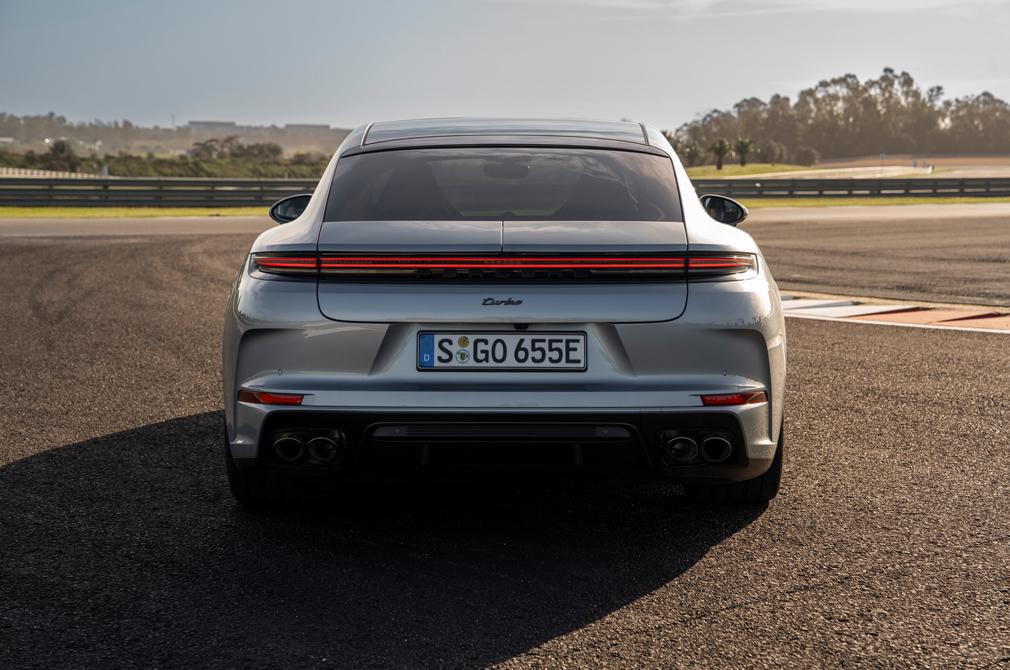It may not be immediately obvious, but the Porsche Panamera is now in its third generation.
Yes, the silhouette of Porsche’s four-door limousine is familiar, but if you look closer, you’ll find new items such as headlamps that blend with the more pronounced front fenders. The front bumpers also have larger air intakes for enhanced cooling.
At the rear, the Panamera’s single light strip is now more obvious, and appears uniform across the width of the car. For the first time, centre-locking wheels are now available as an option.

The changes to the interior are more apparent. The cockpit follows the theme of current Porsches, with extensive digitalisation and the use of piano black trim. Thankfully, Porsche has retained physical buttons for controlling the climate.
However, many other functions, including the one to adjust airflow directions, are only accessible via the 12.3-inch touchscreen panel. Buyers can also option an additional 10.9-inch touchscreen for the front passenger, which lets them stream videos, use the infotainment system, or monitor the vehicle’s performance.
Digitalisation has also affected the instrument panel. Sadly, the analogue tachometer so loved by fans (and a feature that Porsche resisted changing for a long time) has finally been replaced by a digital one on the 12.6-inch cluster.

MINIMALIST MOVES
Further signs of the “less is more” theme include replacing the traditional gearshift lever with a toggle, and the switch from three-chamber air suspension to Porsche Active Ride, which only uses a single chamber. This, Porsche says, is as good or even better than before, thanks to the integrated active damper technology.
The new suspension also eliminates the need for anti-roll bars. The new dampers use an electric hydraulic pump that selectively and rapidly increases or decreases pressure in each damper to resist roll and body movement.
As a result, the Panamera feels flat while cornering, with nary a hint of roll even when pushed hard. And since there are no anti-roll bars, you don’t have to deal with the harshness that comes with them.

The Turbo E-Hybrid is the range-topping model of the Panamera family. It is impressive and well-sorted, with a suppleness that competes with luxury saloons. The Panamera Turbo’s ability to remain on an even keel even when driven over undulating roads makes it a superb grand tourer that remains fun to drive hard.
Now, Porsche’s trick suspension is not entirely new as Citroen has attempted it before. But while Citroen uses incompressible hydraulics, Porsche utilises air suspension as the primary spring, and is thus able to offer a smoother ride over harsh surfaces such as road joints.
ELECTRIFIED TURBO
In Europe, sales of new, pure ICE cars are expected to end in 2035. But Porsche is hoping that models like the Panamera Turbo E-Hybrid - a plug-in hybrid - will still be around after that.
Powering this flagship Panamera is a twin-turbocharged 4-litre V8 that’s paired to a 188hp electric motor, which in turn is fed by a 25.9kWh battery. Total system output is 671hp, while combined torque stands at 930Nm.
With the battery fully charged, the Panamera Turbo E-Hybrid can cover up to 92km and has a top speed of 140km/h in pure electric mode. More exciting, though, is the fact that despite weighing over 2.3-tonnes, the Panamera Turbo goes from a standstill to 100km/h in 3.2 seconds.

Driven around the roads in Germany’s Black Forest, I discover how the Panamera Turbo covers ground at a startling rate, with its all-wheel-drive system helping you put the power down even on damp roads.
Cornering so flat in such a big sedan is a remarkable, if slightly alien, experience. Porsche has put in the effort to ensure it delivers the typical driving characteristics expected of the brand. Thus, the Panamera Turbo is accurate, poised, immersive, and engaging. It is a very polished and well-curated performance that deserves the Porsche badge.

One would think that the Taycan would eventually kill off other Porsche models, but the car proves there is obviously more to come from the carmaker’s hybrid-combustion models.
More than just a display of engineering prowess, the Panamera Turbo has perhaps granted a permanent stay of execution for the internal combustion engine.

Porsche Panamera Turbo E-Hybrid 4.0 (A) ENGINE 3996cc, 32-valves, V8, bi-turbo, plug-in hybrid TOTAL SYSTEM POWER 671hp (680PS) TOTAL SYSTEM TORQUE 930Nm POWER TO WEIGHT 284.3hp per tonne GEARBOX 8-speed dual-clutch with manual select 0-100KM/H 3.2 seconds (with Sport Chrono Package) TOP SPEED 315km/h CONSUMPTION 58.9km/L - 83.3km/L (combined) PRICE EXCL. COE From $1,053,888 AGENT Porsche Singapore
Porsche Taycan review: Surprisingly entertaining
Mercedes-AMG reveals new S63 E, the most powerful S-Class yet
Audi RS7 Sportback review: Part-limousine, part-cruise missile


